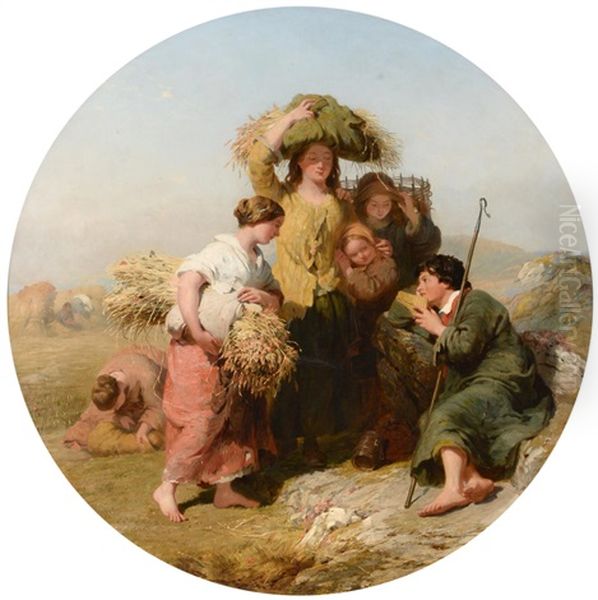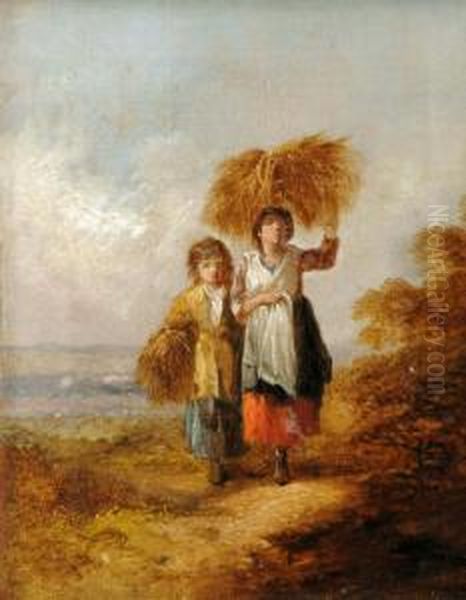James John Hill (1811-1882) stands as a notable figure in nineteenth-century British art. Primarily recognized as a painter, he demonstrated considerable skill in both landscape and portraiture, carving a niche for himself with charming depictions of rural life, particularly scenes featuring attractive young figures set against pastoral backdrops. His career spanned a significant portion of the Victorian era, marked by consistent exhibition activity and connections within the London art world.
Early Life and Artistic Foundations
James John Hill entered the world in 1811. One source identifies his birthplace as Broad Street, London, while another suggests Broad Street, Birmingham. He was one of six children born to Daniel Hill, described as a plater, and Elizabeth Norman (née Rowland). His family included brothers Daniel Hill Rowland, who pursued careers as a locksmith and architect, and Daniel Hill Ratcliffe, who later became a Liberal Member of Parliament.
An important figure in his early life was John James Masquerier. The provided texts offer slightly differing accounts of this relationship: one source names Masquerier as Hill's godfather, after whom he was named, and notes Masquerier was the father of a friend. Another source refers to James Masquerier John (presumably the same individual, given the context) as his adoptive father , who also happened to be the father of a friend. Regardless of the precise nature of the relationship (godfather or adoptive father), Masquerier appears to have played a significant role in Hill's upbringing and later connections.
Hill's formal education took place at Hazelwood School in Edgbaston. This institution was notably founded by the educational reformer Rowland Hill, a prominent figure distinct from the artist's family members. This schooling provided a foundation before he pursued dedicated artistic training.
His artistic development continued under the tutelage of Joseph Barber, likely at Barber's academy or studio in Birmingham. During this formative period, Hill studied alongside other aspiring artists who would also make names for themselves, including Thomas Creswick and Frederick Henry Henshaw. This shared learning environment undoubtedly contributed to his burgeoning skills and understanding of contemporary artistic trends.
Artistic Career and Development in London

After marrying in the late 1830s and starting a family (he eventually had three children), James John Hill relocated to London. Seeking to establish himself within the capital's vibrant art scene, he rented various studios situated in the city's recognized artist quarters. This move marked a significant step in professionalizing his career and engaging directly with the center of the British art world.
His association with the Society of British Artists (SBA) became a cornerstone of his career. Elected a member in 1842, Hill remained a prolific contributor to the society's exhibitions for the next four decades. His commitment was further recognized when he served as the society's Vice President for a period of six years, reportedly beginning around 1868.
Beyond the SBA, Hill also sought recognition at other prestigious venues. His works were accepted for exhibition at the esteemed Royal Academy of Arts and the British Institution, further solidifying his presence and reputation within the broader artistic community. Consistent exhibition activity was crucial for visibility and sales during this period.
Style and Thematic Focus
James John Hill developed a distinctive artistic style, particularly noted for his treatment of landscape and figurative subjects drawn from rural life. He possessed a clear affinity for depicting the countryside, often focusing on idyllic scenes populated by appealing young peasant girls and boys. These portrayals frequently emphasized beauty and a certain rustic charm.
His landscape painting was significantly informed by his travels. Journeys through the English Midlands in 1854, as well as documented trips to Ireland in 1854 and 1856, provided direct inspiration and subject matter. These experiences allowed him to study nature firsthand, which is reflected in the detail and atmospheric quality of his landscape work. He also undertook sketching expeditions in Wales, often in the company of fellow artist Frederick Henry Henshaw.
Hill's style is characterized by a blend of gentle social realism and a poetic, sometimes almost mythological, atmosphere. While his works often depicted the realities of rural labour, such as gleaning or other farm tasks, they typically presented these scenes through a lens of pastoral beauty rather than harsh critique. He showed a keen eye for detail and tone, capturing the nuances of light and texture in the natural world.

An interesting formal aspect noted in some analyses of his work is the occasional use of the circular canvas, or 'tondo'. This format, less common than rectangular canvases, is sometimes interpreted as imbuing his subjects with symbolic weight, perhaps alluding to cycles of life, nature's inherent sanctity, or a contained, jewel-like perfection within the scene.
Representative Works
Among James John Hill's extensive output, The Gleaners, painted around 1851 and exhibited at the Royal Academy, is frequently cited as one of his most significant and representative works. This painting encapsulates many of the key elements of his style: the focus on rural labour, the depiction of attractive young figures (gleaners were often women and children), and the characteristic blend of observed reality with an idealized, slightly poetic sensibility. It stands as a prime example of his successful formula.
While renowned for his rustic genre scenes, Hill was also a capable portraitist. His connection with the prominent philanthropist Angela Burdett-Coutts led to numerous commissions. He painted portraits for her, and notably, also undertook studies of animals, including her dogs. This patronage highlights his versatility across different genres.
Furthermore, Hill produced pure landscapes, devoid of prominent figures, showcasing his skill in capturing the natural environment. His collaborative work also forms part of his oeuvre, particularly the figures he contributed to the landscape paintings of Henry Bright, often intended for reproduction.
Collaborations and Artistic Circle
Collaboration and professional relationships were integral to James John Hill's career. His early studies alongside Thomas Creswick and Frederick Henry Henshaw under Joseph Barber established connections that continued into his professional life.
His association with Frederick Henry Henshaw was particularly notable. The two artists worked together, with one source mentioning collaborative work at Woodhouses, Aston Park, and another specifying Packington Park in Warwickshire. They also embarked on sketching tours together, exploring the landscapes of Wales and Ireland, sharing insights and likely influencing each other's work. Some accounts suggest that Hill's figures occasionally appeared in paintings by Henshaw (and potentially an artist named Bridges, though this connection is less detailed in the provided source).
Another significant collaboration involved the artist Henry Bright. Hill frequently painted the figures within Bright's landscape compositions. This partnership was particularly relevant for works intended for reproduction, such as lithographs published in popular periodicals like the Illustrated London News. Hill's skill in depicting appealing rustic figures complemented Bright's landscape settings.
The role of John James Masquerier (his godfather or adoptive father) extended beyond his early life. Masquerier, himself connected within artistic and philanthropic circles, introduced Hill to the immensely wealthy banking heiress and philanthropist Angela Burdett-Coutts. This introduction proved pivotal for Hill's career.
Baroness Burdett-Coutts (ennobled in 1871) became not just a major patron but also a close personal friend to Hill. She commissioned a substantial number of works from him, spanning portraits, animal studies, and his signature rustic scenes. This consistent support provided significant financial stability and prestige. Some of the works commissioned by the Baroness were later acquired by Herbert Ingram, the founder of the Illustrated London News, further enhancing the visibility of Hill's art through potential reproduction.
The artists mentioned in connection with James John Hill in the provided texts include: John James Masquerier (as a figure of influence and connection), Joseph Barber (as his teacher), Thomas Creswick (as a fellow student), Frederick Henry Henshaw (as a fellow student and collaborator), and Henry Bright (as a collaborator).
Later Life and Legacy
James John Hill continued to paint and exhibit actively throughout much of his later life, maintaining his long association with the Society of British Artists and other institutions. His work remained popular, finding favour with patrons like Baroness Burdett-Coutts and reaching a wider audience through reproductions.
His life concluded in Highgate, a suburb of London. He passed away on January 27, 1882, succumbing to tuberculosis. He left behind a considerable body of work exploring the landscapes and rural life of Victorian Britain.
James John Hill's contribution to British art lies in his consistent production of well-crafted landscapes and, most distinctively, his charming and idealized depictions of rural figures and scenes. He successfully navigated the London art world, securing membership and leadership roles in prominent societies and attracting significant patronage. His ability to blend observational detail with a poetic, often sentimental, view of country life resonated with Victorian tastes. The reproduction of his work in illustrated newspapers also played a role in disseminating his imagery to a broad public. He remains a recognized exponent of the rustic genre and landscape painting traditions of his time.